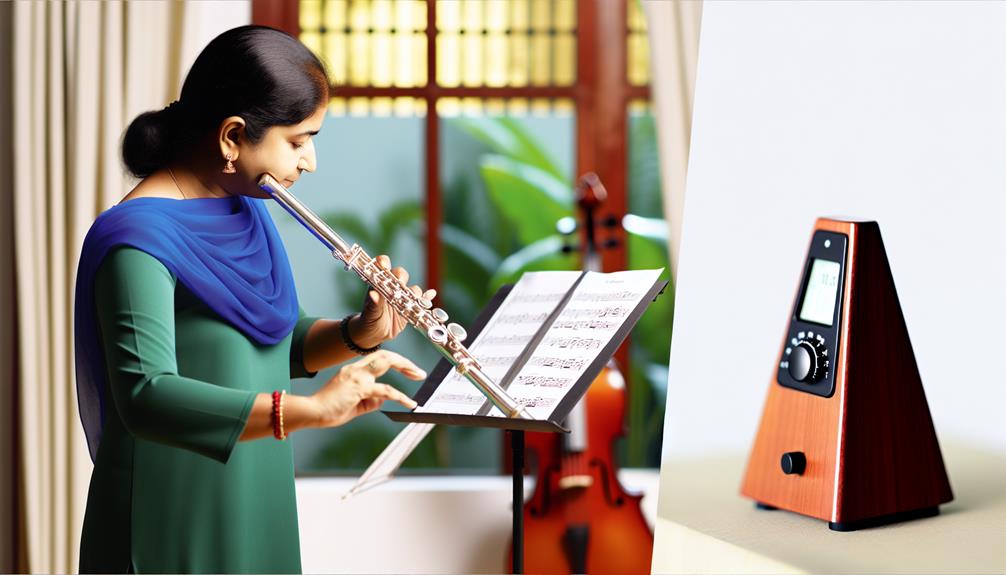Understanding how to decipher sheet music is a fundamental aspect of a flutist's musical journey. From unraveling the complexities of key signatures to grasping the nuances of musical symbols, each component plays a crucial role in shaping a musician's performance. However, there is a significant element beyond just recognizing these symbols that can truly elevate a flutist's interpretation of a piece. Stay tuned to discover the secret ingredient that can transform a simple rendition into a captivating musical experience.
Key Takeaways
- Learn key signatures for tonal guidance.
- Understand note values for rhythm accuracy.
- Master staff navigation for note reading.
- Interpret musical symbols for expression.
- Recognize time signatures for rhythmic structure.
Understanding Key Signatures
Key signatures are fundamental symbols in sheet music that provide important information about the tonality of a piece and the specific notes that may be altered throughout the musical composition. Understanding key signatures is crucial for flutists as it helps them navigate through the music with ease and accuracy. Key signatures consist of sharps or flats placed at the beginning of a staff, indicating which notes are to be consistently raised or lowered throughout the piece.
Identifying accidentals within a key signature is essential for flutists to interpret the music correctly. Accidentals are symbols that raise or lower the pitch of a note by a half step. By recognizing the accidentals in a key signature, flutists can anticipate which notes will be affected and play them accordingly.
Practice scales in different keys to familiarize yourself with the corresponding key signatures and the accidentals they contain. This will not only enhance your understanding of key signatures but also improve your overall fluency in playing various musical pieces.
Identifying Note Values
Understanding note values is essential for flutists as it forms the foundation for interpreting and playing rhythms accurately in sheet music. Note values indicate the duration of a sound, helping musicians create intricate rhythm patterns by combining different note values. When reading sheet music, flutists must pay close attention to note values to ensure they play each note for the correct duration. Counting beats is crucial in mastering note values, as it allows flutists to maintain a steady tempo and accurately execute musical phrasing.
In addition to establishing rhythm patterns, understanding note values is vital for navigating musical phrasing and tempo changes. Different note values contribute to the overall musical expression, emphasizing certain notes within a piece and creating dynamic contrasts. Flutists must be able to recognize note values quickly to adapt to tempo changes smoothly and convey the intended musical interpretation effectively.
Navigating the Staff
As flutists progress in their musical journey, mastering the skill of navigating the staff becomes paramount for accurately interpreting and performing sheet music. The staff, consisting of five lines and four spaces, is where musical notes are placed to represent pitch and duration. Understanding note placement on the staff is crucial. Each line and space corresponds to a specific note, with higher notes placed higher on the staff and lower notes placed lower. Flutists must be able to quickly identify these notes to play the correct pitches.
Clef interpretation is another essential aspect of navigating the staff. The treble clef is typically used for flute music and indicates the positioning of notes on the staff. The treble clef symbol, also known as the G clef, curls around the line representing the note G above middle C. This positioning helps flutists determine the placement of other notes on the staff relative to G, aiding in accurate note reading and playing.
Interpreting Musical Symbols
Interpreting musical symbols is a fundamental skill that enhances a flutist's ability to accurately interpret and perform sheet music with precision and artistry. Tempo markings play a crucial role in indicating the speed at which a piece should be played. Whether it's the lively allegro or the serene adagio, these markings guide the flutist in setting the right pace, bringing life to the music. Expression markings, such as dynamics (forte, piano) and articulations (staccato, legato), add depth and emotion to the performance, shaping the music's mood and intensity.
Musical phrasing is another essential aspect of interpreting sheet music. It involves understanding how notes are grouped together to convey musical ideas effectively. By recognizing phrasing marks like slurs or breath marks, flutists can structure their playing to create seamless and expressive musical phrases. Bowings, although more commonly associated with string instruments, are also relevant for flutists. They indicate the direction and manner in which notes should be played, influencing the overall sound and articulation of the music.
Mastering the interpretation of these musical symbols allows flutists to go beyond simply playing the notes on the page. It enables them to infuse their performances with nuance, emotion, and personal artistry, captivating audiences and bringing the music to life.
Recognizing Time Signatures
A foundational element in the realm of sheet music comprehension lies in the ability to discern and accurately identify time signatures, a critical aspect that underpins the rhythmic structure of musical compositions. Time signatures are denoted by two numbers placed at the beginning of a piece of music, indicating the number of beats in each measure and which note value constitutes a single beat. Understanding time signatures is crucial for maintaining the proper pace and rhythm while playing music.
Tempo markings play a significant role in interpreting time signatures, as they indicate the speed at which a piece of music should be played. By recognizing the tempo markings alongside the time signature, flutists can grasp the intended feel and energy of a musical passage, bringing it to life with the right rhythmic nuances.
Counting beats is another essential skill when it comes to recognizing time signatures. By internalizing the pulse of the music and accurately counting the beats within each measure, flutists can navigate complex rhythms with confidence and precision. Practicing counting beats in different time signatures is key to developing a strong sense of rhythm and improving overall musical performance.
Differentiating Between Notes and Rests
Mastering the distinction between notes and rests is essential for flutists aiming to convey musical expression and precision in their performances. Rest durations and rhythmic values play a crucial role in creating the rhythmic framework of a piece. Understanding the different types of rests, such as whole rests, half rests, quarter rests, and so on, is fundamental in accurately interpreting the music's timing and phrasing.
Note placement is equally significant when differentiating between notes and rests. Notes indicate when a sound should be played, whereas rests signify moments of silence within the music. Counting rhythms accurately is essential for maintaining the piece's tempo and ensuring cohesion among musicians in an ensemble setting.
As a flutist, developing a keen awareness of both notes and rests allows for a more nuanced and expressive performance. It enables the player to navigate complex rhythmic patterns with ease and confidence. By mastering the art of distinguishing between notes and rests, flutists can elevate their musical interpretations and deliver captivating performances that resonate with audiences.
Exploring Dynamics and Articulations
Exploring the nuances of dynamics and articulations in sheet music opens up a world of expressive possibilities for flutists seeking to infuse their performances with depth and emotion. Dynamics refer to the volume at which music is played, ranging from soft (piano) to loud (forte), allowing for a wide spectrum of intensity. Understanding articulations is equally crucial, as they dictate how each note is played, be it smoothly (legato) or detached (staccato), adding texture and character to the music.
Phrasing techniques play a vital role in conveying the emotional content of a piece. By shaping phrases with dynamic contrasts and subtle articulations, flutists can evoke a range of feelings, from joy to sorrow, capturing the essence of the music. Expressing emotions through music is a deeply personal journey that requires not only technical proficiency but also a profound connection to the music being performed.
As flutists delve into the world of dynamics and articulations, they unlock the potential to breathe life into their music, creating captivating performances that resonate with audiences. By mastering these elements, flutists can craft interpretations that are not only musically satisfying but also emotionally compelling, forging a profound connection between performer, music, and listener.
Learning About Repeats and Endings
Understanding the significance of repeats and endings in sheet music is essential for flutists aiming to interpret compositions accurately and effectively. Repeats and endings play a crucial role in shaping the structure and flow of a piece, guiding musicians through the musical journey with clarity and intention.
Here are some key aspects to consider when delving into the world of repeats and endings:
- Mastering transitions: Pay close attention to how repeats and endings affect the overall structure of the music. Smooth transitions between sections are vital for maintaining the coherence and expressiveness of the piece.
- Musical phrasing: Utilize repeats and endings to enhance your musical phrasing. By understanding where sections repeat or conclude, flutists can create nuanced interpretations that capture the essence of the composition.
- Memorizing: Repeats and endings can aid in memorization by providing anchor points within the music. Use these markers to solidify your memory of the piece and strengthen your performance.
- Performance techniques: Experiment with different approaches to repeats and endings during practice sessions. Explore variations in dynamics, articulations, and tempo to discover the most compelling way to interpret these elements.
- Interpretive choices: Embrace repeats and endings as opportunities for artistic expression. Make conscious decisions about how to navigate these elements to convey the composer's intentions effectively.
Understanding Ties and Slurs
Ties and slurs are fundamental notations in sheet music that are crucial for shaping the musical phrases and articulation in flute performances. While both ties and slurs appear as curved lines connecting notes, it is essential to identify the differences between them to interpret the music accurately.
A tie is a curved line that joins two notes of the same pitch, indicating that the duration of the notes should be combined. This means that instead of playing the same note twice, you hold it for the total duration of the tied notes. Ties are crucial for creating smooth, connected sounds in music, allowing for a seamless flow between notes.
On the other hand, a slur indicates that the notes under the curve should be played smoothly without separation. Unlike ties, which combine the duration of notes, slurs focus on the articulation and phrasing of the music. Mastering the technique of slurring notes on the flute is essential for achieving a more expressive and musical performance.
To master these techniques effectively, it is crucial to practice playing tied and slurred notes slowly at first, paying close attention to the transitions between notes. By understanding the differences between ties and slurs and honing your skills in executing them, you can enhance the musicality and expressiveness of your flute playing.
Applying Music Terminology
In the realm of musical interpretation and performance on the flute, the application of music terminology serves as a cornerstone for communicating and executing nuanced musical expressions. Understanding music theory and performance techniques is essential for flutists to convey the intended emotions and messages within a piece effectively. Here are five key aspects of applying music terminology that can greatly enhance a flutist's performance:
- Dynamics: Mastering the variations in volume, from pianissimo to fortissimo, adds depth and emotion to the music.
- Articulation: Utilizing different articulations such as staccato, legato, or accents can significantly impact the overall feel of the piece.
- Tempo: Adhering to the specified tempo markings ensures the music is played at the correct speed, maintaining its intended character.
- Expression markings: Paying attention to markings like crescendo, diminuendo, or fermata helps in shaping phrases and creating musical tension.
- Phrasing: Understanding how to breathe and phrase music appropriately can transform a series of notes into a cohesive and expressive musical statement.
Frequently Asked Questions
How Can I Improve My Sight-Reading Skills as a Flutist?
To improve sight-reading skills as a flutist, focus on mastering flute fingering for smooth transitions between notes. Develop breath control to sustain phrases without interruption. Practice regularly with a variety of music to enhance sight-reading abilities.
Utilize metronomes for accurate timing and gradually increase difficulty levels. Seek guidance from a music instructor for personalized feedback and tips on effective sight-reading techniques. Consistent practice and dedication will lead to significant improvements in sight-reading proficiency.
What Are Some Common Techniques for Memorizing Sheet Music?
To enhance memorization of sheet music, employ potent memory tricks and practice techniques. Note visualization aids in connecting the dots, while mnemonic devices like acronyms or word associations can cement musical phrases in your mind.
Consistent rehearsal and deliberate practice foster familiarity with the composition, making recall smoother. Embrace these techniques wholeheartedly to enrich your musical journey and cultivate a deep connection with the music you perform.
Is It Necessary to Learn Music Theory to Read Sheet Music Effectively?
Understanding music theory is essential for effective sheet music comprehension. It provides the foundation necessary to interpret musical symbols, grasp rhythm and pitch, and ultimately bring a piece to life.
By learning music theory, individuals gain a deeper appreciation for the language of music, enhancing their ability to read and perform sheet music with accuracy and expression.
The importance of music theory in reading sheet music cannot be overstated.
How Can I Develop a Better Sense of Rhythm While Reading Music?
Developing a better sense of rhythm while reading music involves incorporating rhythm exercises and metronome practice into your routine.
Rhythm exercises can help you internalize different rhythmic patterns, while practicing with a metronome can assist in maintaining a steady tempo and improving your timing.
By combining these techniques, you can strengthen your rhythmic skills and enhance your overall musical performance.
Consistent practice and dedication are key to refining your sense of rhythm.
Are There Any Tips for Interpreting the Emotional Expression in Sheet Music?
Interpreting the emotional expression within sheet music is a nuanced art, akin to deciphering a painter's brushstrokes. To capture the essence of a piece, focus on musicality and artistic expression.
Delve into the composer's intentions, study performance practices, and infuse your playing with personal emotion. By engaging with the music on a deep level, you can bring out its full emotional spectrum, creating a captivating and moving performance.
Conclusion
In mastering the art of reading sheet music, flutists unlock the door to a world of musical expression and interpretation.
Just as a skilled navigator charts their course through uncharted waters, a flutist navigates the staff with precision and grace.
By understanding the language of music notation, flutists can breathe life into the notes on the page, creating a symphony of sound that resonates with beauty and emotion.





